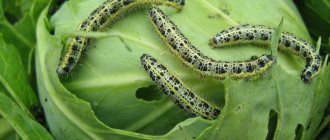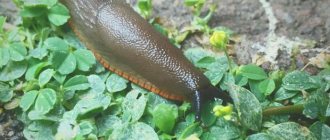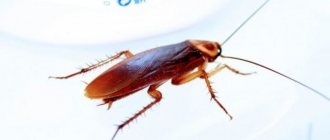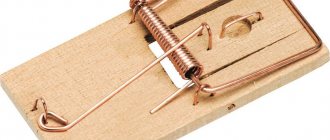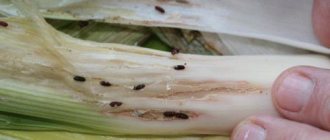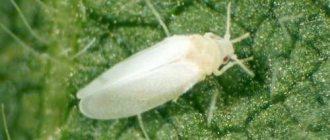What harm can aphids cause to cabbage?
Aphids are small insects, no more than 4 mm in size, from the order Homoptera. There are many types of aphids in nature. Plants from the Cruciferous family, which includes cabbage, are attacked by the green cabbage aphid. The aphid has a piercing-sucking mouthparts, with which it pierces the membrane of the cabbage leaf and sucks out the juice from it.
Aphids on cabbage reproduce quite quickly; during the season, a female can produce offspring 15 times, laying 40 eggs in each cycle. Until mid-summer, wingless aphids damage vegetable plantations, and in a later period winged individuals hatch from the eggs. From this moment on, the insect has unlimited possibilities; it migrates over long distances in search of untouched cabbage plantings.
Here is the harm of this pest:
- Large colonies of insects suck all the nutritious juices out of the cabbage, depriving it of the opportunity to grow further. As a result of this effect, cabbage leaves curl and dry out. The crop losses will be incalculable.
- The insect carries pathogens of many vegetable diseases on its abdomen and legs. Moving from one plant to another, aphids carry pathogenic bacteria, viruses and fungi. As a result, cabbage develops the following ailments:
- gray rot;
- mosaic;
- blackleg;
- black ring spot;
- mucous bacteriosis;
- necrotic jaundice.
- As a result of their vital activity, aphids secrete a sweetish liquid that ants adore. Therefore, these insects can often be seen together, and ants do their best to protect aphids. In particular, they protect aphid eggs from attacks by other predatory insects and during the summer they drag eggs onto plants, facilitating the spread of aphids.
Having discovered aphids on cabbage, you cannot remain indifferent to it even for a short time. You need to immediately get involved in the fight against the insect and treat it with some kind of insecticide.
Important! In the fight against aphids on cabbage, an integrated approach should be taken. This means that in order to completely exterminate aphids, you will also have to destroy ants at the same time.
What is a pest?
There are many varieties of aphids, classified by color, size and lifestyle. For cabbage bushes, the main danger is green aphids, which prefer to settle on young plants. Aphids feed using a long proboscis.
The insect sucks the sap from the plant, leaving a dry shell. In addition, aphids are carriers of more than 20 types of infectious diseases of garden crops. It is also worth looking at what aphids look like on peppers in a greenhouse.
Aphids on cabbage
Moving freely between plants, small insects infect everything in their path. The spread of aphids is facilitated by warm, sunny weather - it is under such conditions that the insect can give birth to offspring up to twenty times per season.
In spring and summer, mostly females are born and lay larvae without mating. By autumn, males appear that are capable of flying over considerable distances. Aphids lay fertilized eggs on weeds and garden plants of the cruciferous family. They survive the winter safely, and with the first rays of warmth they are ready to actively search for food.
In the video - aphids on cabbage:
Signs of pest damage
Aphids can appear on cabbage suddenly, and this moment should not be missed. The insect reproduces quickly, so it is very important not to miss the moment of its settling on cabbage. Cabbage plots should be inspected daily, paying special attention to the underside of the leaves.
The following signs indicate that the pest is already nearby:
- cabbage leaves lose their usual color, become brittle, their tops become colorless;
- sections of the leaf between adjacent veins seem to decay and begin to dry out;
- cabbage loses its green color more and more, the leaves become covered with yellow spots and gradually dry out;
- the plant is severely retarded in growth, quickly losing its vitality;
- parasitic insects leave their waste products on the leaves in the form of a sticky, dirty coating;
- with a large number of parasites on one plant, the leaves take on the shape of a tube, are severely deformed, and heads of cabbage do not form;
- If the colony is severely infested, live aphids can be seen on the cabbage with the naked eye.
Attention! When inspecting cabbage plants for aphids, do not be too lazy to bend down as low as possible. These insects first colonize the lowest leaves, and only then gradually climb higher.
Folk methods of struggle
Vegetable growers in their practice use various effective methods to get rid of aphids, but most often they try to save cabbage:
- insecticides;
- folk remedies.
Treating cabbage with commercial preparations almost always gives the desired result. However, not every gardener is ready to use chemicals on his own plot, especially when there is little time left before harvesting. Therefore, he tries to treat cabbage against aphids with folk remedies.
You can destroy the pest on cabbage in this way thanks to numerous folk recipes, the main ones of which are given below.
Tobacco
You can treat cabbage at home against aphids with tobacco. This method is used everywhere. The insect cannot tolerate the smell of tobacco, so with its help it is possible to protect cabbage plantings from its attacks. You can spray the heads of cabbage in the garden with a decoction or infusion of tobacco. The methods for preparing them vary.
The decoction is prepared as follows:
- take 200 g of tobacco leaves;
- fill them with 5 liters of water;
- cook over low heat for 1.5 hours;
- add a little soap for sticking;
- wait until the drug cools down;
- add the part of the water that has boiled away.
The prepared decoction can be used to remove aphids from cabbage. The plants should be sprayed so that the leaves are completely wetted. Similar procedures can be performed weekly.
Fighting aphids with traditional methods turns out no worse if you use tobacco infusion. It is prepared this way:
- take 200 g of shag;
- pour 5 liters of boiling water over it;
- add a little soap for sticking;
- close the container with a lid;
- insist for 2 days.
You can water the cabbage with tobacco infusion weekly. It is important that the liquid also gets on the undersides of the leaves, where the pests hide.
Vinegar
You can poison aphids on cabbage with table vinegar, which has a sharp, sour odor. This smell is so unbearable for insects that they immediately begin to retreat from the cabbage bed. A vinegar-based solution should be made on the day of use according to the following algorithm:
- pour a full bucket of water;
- add 190 ml of table vinegar to it;
- pour 35 g of liquid soap into the composition;
- stir the solution.
The prepared solution can be used to treat cabbage seedlings and plantings in open ground, trying to pay more attention to the underside of the leaves.
Ammonia
You can protect cabbage beds with ammonia. It also has a sharp, persistent odor, thanks to which it is possible to get rid of even adult individuals. The solution is prepared according to the following recipe:
- pour a full bucket of water;
- add 50 ml of ammonia there;
- add 100 g of crushed laundry soap to the composition;
- Stir the solution until the composition is homogeneous.
Important! It is allowed to apply this solution no more than 2 times a month, otherwise cabbage leaves will be deformed and growth processes will be disrupted.
Ash and spices
Ash is often used as a control measure against a whole range of diseases and harmful creatures. Cabbage aphids also do not tolerate ash, especially in combination with kitchen spices. Knowing about this phobia of aphids, people have come up with and use in practice a recipe based on these substances:
- take a glass of ash and pour it into a bucket of water;
- add 3 tbsp to the bucket. laundry soap;
- add 1 tbsp to the mixture. ground red pepper;
- stir the solution and leave for a day.
Attention! Cabbage can be treated with this solution weekly until the insects are completely expelled. Instead of pepper, crushed cinnamon can be used.
Tar soap
Tar soap is useful because it not only repels aphids, but also disinfects the leaves from the penetration of pathogenic microorganisms. The preparation method is very simple - dilute 100 g of this soap in 10 liters of water and mix the composition well. After this, fill the sprayer with this solution and treat the cabbage heads.
Potato and tomato tops
If tomatoes and potatoes grow in the garden, then it will become even easier to destroy aphids. Based on the tops of these crops, you can prepare an infusion to combat insects:
- take equal masses of potato and tomato tops;
- pour boiling water over them;
- leave for 3 days;
- strain the mixture.
Cabbage can be treated with this infusion twice a week.
Yarrow
Yarrow can be used for the same purposes. A decoction based on it is prepared as follows:
- chop 400 g of fresh or 200 g of dried herb;
- Place the mixture in a saucepan, pour in 1 liter of water;
- boil;
- Cool the mixture and strain.
Important! Before use, dilute the resulting stock solution in a ratio of 1:10.
Garlic
Garlic is a vegetable that also has a pungent odor, so it can be used against aphids. Garlic broth is prepared according to the following algorithm:
- 800 g of unpeeled garlic cloves are placed in a pan;
- add 10 liters of water to the garlic;
- bring to a boil, then simmer for another 2 hours over low heat;
- then the broth is cooled and filtered.
Important! Before use, the composition is diluted with raw water in a 1:1 ratio.
Bay leaf
Bay leaves are rich in essential oil, the aroma of which also repels aphids. A decoction is prepared based on this spice. To do this, 10 g of dry leaf is poured with one liter of boiling water. After settling and cooling the solution for an hour, remove the bay leaf from it and begin spraying.
Methods for controlling aphids
After discovering aphids in your garden plot, you must immediately begin to combat them. In this case, it is advisable to immediately apply several methods, each of which will be considered separately.
Biological and mechanical methods
It is proposed to breed birds and insects on the site, which can destroy this pest before it turns into an adult insect.
For these purposes, you need to attract the following birds to the cabbage patch:
- tits;
- warbler;
- linnets;
- Vorobyov.
To do this, you need to install special feeders filled with grain crops:
- sunflower seeds;
- millet;
- millet;
- oats
Tits will also be happy with hung unsalted lard, hard-boiled eggs, and grained cottage cheese.
Among insects, it is better to attract those individuals that are able to cope with aphid larvae. These include:
- Ladybugs . They can be attracted by installing log houses with holes for wintering on the site. This method is relevant for southern areas where winters are warm. In other regions, to attract ladybugs in the garden, it is better to plant the following plants: yarrow;
- tansy;
- buckwheat;
- dill;
- angelica;
- sweet clover
In order to repel aphids, you can also plant spicy plants on the site, in particular:
- basil;
- mint;
- garlic;
- onion;
- fennel;
- lavender.
Some experienced gardeners sow tobacco between the beds, as it destroys cabbage caterpillars and aphids.
These methods are acceptable in the early stages of cabbage infestation by aphids, when it is still in the form of a larva. In case of a large pest invasion, they are ineffective, so they will have to be combined with the use of chemicals.
Physical way
Acceptable at the stage when there are still few pests in the garden. In this case there is no need to use chemicals. The method is to destroy aphids with your own hands. To do this, the beds must be carefully inspected, and any identified pests must be crushed directly on the cabbage.
Chemical method
The most reliable and effective method of combating aphids, which involves treating cabbage with biologically active preparations and chemical insecticides. Popular means include:
- Pyrethrum . Biological preparation in powder form based on chamomile. Before processing, it must be diluted in water at the rate of 60 g per 10 liters of liquid. Spray cabbage with it in calm weather once every 2 weeks throughout the vegetable growing season.
- Karbofos . A toxic but very effective broad-spectrum remedy that helps get rid of adult pests and larvae. The insecticide must be diluted in water at the rate of 7.5 g per 5 liters. When spraying plants, wear equipment (respirator, rubber gloves). The weather should be dry, without gusty winds. Use the drug 1 time. After treating cabbage, the parasites will die within 2 hours, and the protective effect will last for 20 days or more, depending on weather conditions.
- Seifos . Not as poisonous as Karbofos. It is more often used in cases where the seedlings were not treated before planting in a permanent place. The plant should be sprayed with a solution of 5 g of product per 5 liters of water. After spraying, the aphids disappear within 2-3 days.
- Spark . The insecticide is sold in several variations, so its packaging may have the prefix “Gold”, “Bio” or “Double effect”. Available in powder, tablet or liquid form. Before use, the drug must be diluted in water according to the instructions on the package. After treatment, plant protection lasts about 3 weeks. To consolidate the effect, it can be re-applied after 15 days, and then once a month throughout the growing season. The last treatment should be carried out at least 20 days before harvest.
- Deltamethrin . A broad-spectrum insecticidal drug that can immediately destroy pests, since it blocks the transmission of nerve impulses in them, which leads to their paralysis and death. It is harmless to humans, as it contains only natural ingredients. It begins to act immediately after processing the cabbage and over the next 20 days.
Other drugs based on deltamethrin are also produced, including Decis pro, Fas and Atom.
To prevent aphids from getting used to chemicals, they need to be changed annually. Although their use allows you to quickly get rid of pests, they still pose a danger to the vegetable, so after processing the cabbage should be fed with natural fertilizers.
There are products that simultaneously destroy aphids and feed cabbage. You can learn about one of them from the video below:
Traditional methods
Not all gardeners like chemical treatment of plants. Many people prefer to use folk remedies that do not have a toxic effect. These include:
- Water supplied under pressure . You can get rid of aphids using water supplied through a hose. This creates pressure, causing insects to be washed off the plants. The aphids can no longer crawl back. If you shower frequently, you can gradually get rid of these insects.
- Soap solution . Prepared from laundry or tar soap. For 10 liters of water you need to take 100 g of soap. Spray the heads and legs with the prepared mixture from a spray bottle.
- A mixture of soap and soda . Dilute 1 tbsp in 10 liters. l. soda ash and 1/2 bar of laundry soap, grated on a fine grater. Spray the mixture onto the cabbage.
If you use only soda, it will not linger on the leaves and will quickly be washed away by rain, so it is supplemented with soap.
- Infusion of ash . For a 10-liter bucket of water, take 2 cups of wood ash. Mix the mixture thoroughly and apply it to the cabbage leaves. The ash can also be used in combination with cinnamon and pepper (red and black). Spices need to be mixed in equal proportions and add 200 g of wood ash. Separately, dilute 200 g of laundry soap in 1 liter of warm water, add the finished powder and 9 liters of cool water. Mix the composition thoroughly and use as directed 2 times with intervals of 3 days. For preventative purposes, cabbage can be processed once a month.
- Tobacco decoction . To prepare a concentrated product, you need to grind 10 g of dry tobacco, add 5 liters of water and leave for 24 hours. Next, boil the composition for 2 hours over low heat, after adding another 5 liters of water. Treat cabbage with broth from a watering can or spray bottle.
- Orange peel decoction . Take 2 cups of crushed and dried orange peels, pour warm water over them and leave for 24 hours. Then boil the composition for about 10-15 minutes, strain and dilute with 10 liters of water. At the end, add 100 g of soap and use as directed.
- Spicy infusion . Prepare garlic, horseradish (leaves or roots) and hot pepper. Grind the horseradish, fill the pan a third with it and pour boiling water over it. Leave until the water cools down. Take 2 pods of hot pepper and a head of garlic, finely chop and pour 1 liter of boiled water. Then pour this solution into the pan with horseradish. Before treating plants, add a little liquid soap.
- Infusion of celandine . Take 4 kg of raw or 1 kg of dry herb, pour 10 liters of hot water and leave for 24 hours. Strain the composition, add a little liquid soap and use as intended.
- Infusion of potato or tomato tops . Finely chop fresh tomato or potato tops. You can take both in equal parts. Fill the pan halfway with the prepared raw materials and pour in boiled water. Leave for 24 hours, strain and add a little soap. Treat cabbage with the prepared mixture.
- Sorrel infusion . Aphids do not like the sour infusion of horse sorrel. To prepare it, dig up the roots of the plant, chop it and pour boiling water at the rate of 150 g per 5 liters of water. Leave for 24 hours and use to spray affected plants.
- Dandelion infusion . Dig up dandelion roots (200 g) and collect leaves (500 g). Grind the raw materials and leave for about 3 hours in boiling water. Strain the mixture, add liquid soap and treat the cabbage with it.
- Chamomile infusion . To prepare it, take 100 g of dry raw materials, pour 1 liter of boiling water and leave for 12 hours. Strain the infusion, pour in 2 liters of water, add a little soap and spray the plants with it.
- Infusion of onion peels and onions . Take 2 onions and some onion peels. Chop the onion, combine with the peel and add 2 liters of hot water. Leave for about 4 hours, add soap and use as directed.
- Infusion of pine needles . Prepared within 1 week. Take 1 kg of pine needles and pour 4 liters of boiled water. Leave for a week, stirring the needle daily. Before using the infusion, dilute it with water in equal proportions.
- Vinegar . Repels insects with its pungent odor. You need to take 1 tbsp. l. essences and dilute in 10 liters of water. It is enough to treat cabbage with the product 2 times to completely get rid of aphids.
- Mustard . To treat affected leaves, you can prepare a solution of 50 g of powder per 5 liters of water. In addition, dry mustard should be scattered near anthills, because ants are distributors of aphids.
- Essential oils . In the fight against aphids on cabbage, the use of essential oils - tea tree, lavender, thyme, cedar - shows excellent results. 10 drops of each product should be diluted in 0.5 liters of water and sprayed with the composition on each cabbage leaf. Processing should be done in the evening.
- Ammonia . Like vinegar, it repels insects with its pungent reserve. Helps get rid of even adult aphids. In 10 liters of water you need to stir 50 ml of ammonia and pour the cabbage from a watering can.
You can use an alcohol solution no more than once every 14 days, otherwise excess nitrogen will lead to deformation of the leaves and impaired growth of the vegetable.
How to treat cabbage with an effective folk remedy based on ammonia is described in the video below:
Additional Recipes
In addition to those listed above and briefly described, there are a number of additional recipes, some of which are given below.
Soda
You can also remove aphids from cabbage by using a mixture of soda and soap. The recipe is prepared like this:
- dilute 1 tbsp in 10 liters of water. soda ash;
- add half a crushed bar of laundry soap there;
- The composition is thoroughly mixed until homogeneous.
Milk and iodine
Many people know that using a recipe based on milk and iodine successfully fights powdery mildew on vegetable plants, but it turns out that this can also be used to resist an invasion of aphids.
The recipe is prepared like this:
- take 100 ml of milk with low fat content;
- drip 30 drops of iodine into it;
- mix the composition and add 1 liter of raw water to it;
- Mix again and start spraying the cabbage.
Coca Cola
Oddly enough, you can fight aphids by using a popular soft drink. Coca-Cola is diluted half and half with water and the resulting solution is sprayed on cabbage plantings.
Garlic and onion
Vegetable growers who use garlic and onions against aphids speak very flatteringly about this method. Bulbs and peels are suitable for this. The recipe preparation algorithm is as follows:
- 3 heads of onions or 5-6 heads of garlic, without peeling, chop with a knife;
- add 1 liter of water to the onion or garlic mass;
- put the pan on the fire and boil for half an hour;
- filter, add soap, stir;
- used for their intended purpose.
Celandine
The herb celandine is used in medicine for healing from a certain list of diseases. However, it can be used against aphids if you prepare the following recipe:
- 1 kg of dry or 4 kg of green grass pour 10 liters of heated water;
- leave for 23 hours;
- strain and pour in 35 g of liquid soap;
- use as intended.
Mustard
Mustard is also suitable for expelling aphids from cabbage. To do this, 50 g of mustard powder is dissolved in 5 liters of water. Immediately after preparing the recipe, you should start spraying.
Vodka
In households where vodka is not always used for its intended purpose, it can be used in the fight against aphid colonies. In order not to burn the leaves during the spraying process, vodka or moonshine is diluted in half with water.
Read how to fight aphids by spraying with vodka in this article.
Green soap
A solution based on green soap is prepared as follows:
- 100 g of soap are diluted in 1 liter of heated water;
- add another 9 liters of raw water to the composition;
- apply as intended.
Birch tar
You can use birch tar against aphids on cabbage. It has an oily, rather viscous substance and a strong odor.
The simplest recipe is as follows:
- 10 liters of water are poured into the bucket;
- add 15 g of birch tar and 45 g of crushed laundry soap;
- the solution is stirred for a long time until smooth;
- fill the sprayer with it and moisten the cabbage leaves in the evening.
Boric acid
Boric acid is odorless and tasteless. Once in the digestive tract of an insect, it causes muscle paralysis followed by death.
This product can be used against aphids, ants and other insects in two ways:
- Use of the substance in dry form. The powder is sprinkled in those places where ants or aphids have been noticed.
- Using an aqueous solution. To do this, dissolve a bag of boric acid in 10 liters of water. The resulting solution is watered over anthills and sprayed on cabbage.
How to get rid of aphids on cabbage using traditional methods
Although aphids are a very small pest, they can destroy cabbage extremely quickly. Insecticides are effective methods of control because they destroy not only insects, but also larvae. At the same time, chemical preparations for aphids can accumulate in fruits and cause irreparable harm to human health. In cabbage, almost the entire aerial part is used for food, so the use of insecticides in this regard is doubly dangerous.
The most harmless methods of combating aphids are folk ones. You need to choose the most acceptable and effective one for yourself. There are many of them, since the collection of folk remedies for aphids on cabbage is constantly replenished.
Tar soap
One of the most popular folk remedies for aphids on cabbage is tar soap. The reason for its effectiveness is the birch tar in its composition, which has a detrimental effect not only on aphids, but also on the ants that carry it and infect all new plants.
The most common recipe for preparing a solution is to mix 150 g of tar soap with 10 liters of water. If you treat cabbage with a solution, you can not only get rid of pests, but also restore and regenerate the tissue structure of the leaves of the crop. The wounds heal, heal, and the aphids stop settling in the area due to the sharp, irritating smell of tar. After a week, this activity against aphids on cabbage should be repeated.
Bay leaf
Folk methods for combating aphids on cabbage also include bay leaves, since this spice contains a lot of essential oils. Their aroma repels pests. It is possible to use onion remedy both in dried form and in the form of infusion.
- The first method involves placing dried bay leaves directly under the cabbage plants;
- For the second, you need to pour a package (10 g) of spices with boiling water (1 l), cover with a lid and leave for an hour. After this, strain the liquid and spray the cabbage against aphids. You need to process it again in a few days.
Ammonia
To prepare an insecticidal solution based on ammonia, you will need, in addition to ammonia (50 ml), water (10 l) and laundry soap (40 - 50 g), which should first be crushed on a coarse grater and filled with warm water. For convenience, you can replace laundry soap with shampoo or dishwashing detergent. During the growing season, it is necessary to treat the cabbage with the solution several times every week.
Spraying with ammonia is an effective way to kill aphids on cabbage, but you should follow safety rules when using it:
- protect the respiratory tract with a respirator or mask;
- use rubber gloves;
- prepare a solution for aphids in the open air;
- Keep the mixture out of the reach of children.
Vinegar
A solution against aphids is also prepared from table vinegar, which has a sharp, sour odor. A glass of 6% vinegar is diluted in 10 liters of water, a little liquid soap is added and mixed thoroughly. Thanks to the soap additive, the aphid solution becomes viscous and can stick to cabbage leaves. The seedlings should be treated in such a way that the liquid gets on their back side, where insect pests are most often found. The product is harmless, the heads of cabbage can be consumed at any time after treatment.
In hot weather, spraying is carried out in the evening so that the leaves do not get burned.
The procedure should be repeated after each rain.
Tobacco against aphids on cabbage
Insects cannot tolerate the strong smell of tobacco. To combat aphids, a decoction or infusion of this remedy is used.
To prepare a decoction, 200 g of tobacco leaves are poured into 5 liters of water, then put on fire, brought to a boil and boiled for about 2 hours. The finished decoction is infused until it cools completely, after which the volume is brought to the original volume using the required amount of water. After straining and adding soap, the aphid decoction is ready for use.
To prepare the infusion, pour 200 g of shag into 5 liters of boiling water, close the container and leave for two days.
When processing cabbage, you need to pay attention to the back side of the leaves, where aphid colonies are most often located.
Tomato and potato tops
After pinching the tomatoes and removing the lower leaves of the plants, a large amount of tomato leafy green mass remains, from which it is easy to prepare a remedy for aphids on cabbage.
For this purpose, take 1 kg of fresh shoots that are not damaged by disease and rot, chop them, add a small amount of water and leave for about 4 hours. Next, bring the volume of liquid to 10 liters, filter and use for its intended purpose.
Using the same scheme and in the same ratio, an infusion of potato tops is prepared, used against aphids.
If you treat cabbage with this composition, leaf-sucking insects die. It is worth spraying again after a few days.
It is possible to prepare a decoction from tomato or potato tops, for which you need to pour 0.5 kg of greens into 10 liters of water and cook for about 3 hours over low heat. The decoction is used after filtering, diluted with water in a ratio of 1:3 and adding 30 g of soap.
Sagebrush
Wormwood repels pests from the site if it grows around the perimeter or next to cabbage seedlings. For this purpose, you can lay out wormwood branches scalded with boiling water on the ridges under the plants.
To prepare a decoction for aphids, take about 1 kg of a little dried grass and add water. After boiling for 15 minutes. The wormwood decoction is cooled, filtered and the volume of liquid is brought to 10 liters, diluted with water. For greater effectiveness in the fight against aphids, before processing the cabbage, add 50 g of soap to the broth.
Mixture of ash and spices
An effective remedy for aphids on cabbage is a mixture that has repellent properties. It contains 100 g of wood ash, 1 teaspoon of ground pepper and 100 g of tobacco dust. The mixture is sprinkled around the cabbage seedlings, the soil is loosened to a depth of 2 cm, repeating it every 5 days.
Onion and garlic
Onion-garlic infusion against aphids is prepared as follows:
- 60 g of onion and garlic, chopped.
- Pour the mixture with two liters of water.
- Let it brew for 5 hours.
- Add 10 g of soap to the solution.
- Strain and use to kill aphids.
Spraying cabbage should be carried out several times with a break of 10 days.
Chamomile
An infusion of chamomile flowers helps to completely destroy aphid colonies, provided that plants are repeatedly treated regularly with this product.
For this purpose, take 100 g of inflorescences, pour them into an enamel bowl, pour 1 liter of boiling water, close tightly with a lid and leave to infuse for at least 45 minutes. The resulting aphid infusion is filtered, diluted with water in a ratio of 1 to 10 and poured over the cabbage directly from a watering can.
Review of effective drugs
If using treatment at home with folk remedies can mainly only achieve the expulsion of aphids from cabbage beds, then through the use of professional purchased preparations people achieve their complete extermination. To achieve even better results, it is recommended to alternate chemical agents.
Fitoverm
Among biological products, Fitoverm should be especially noted. With its help, they successfully fight against various parasitic insects.
A solution is used against aphids on cabbage, which is obtained from a liquid concentrate of this substance and water in a ratio of 4:1000. For each hundred square meters, 400 ml of working solution is used.
Spark
An insecticide such as Iskra has long gained popularity among gardeners due to its high efficiency. It can be purchased at retail outlets in the form of a liquid concentrate, tablets or powder.
The drug Iskra for aphids, instructions for use, read this article
On the day of spraying, prepare the solution according to the instructions. The protective effect lasts about 20 days. During this period, adult insects and caterpillars of any age die.
Attention! To completely exterminate insects, treatment should be repeated after 14 days. At least 20 days should pass from the last spraying to harvesting the heads of cabbage.
Tanrek
This insecticide belongs to the group of enteric contact agents. Once on the integumentary membrane or in the intestinal tract of the insect, the chemical blocks nerve impulses, causing rapid death. Tanrek's water-soluble concentrate is available in the form of ampoules, bottles or canisters.
To kill aphids on cabbage by spraying, dissolve 5 ml of the chemical in 10 liters of water.
Aktara
This is a fairly new liquid insecticide, but has already proven itself. Against aphids, this is one of the most popular remedies, and one treatment is almost always enough to exterminate the parasite. The product penetrates the plant tissue 2 hours after treatment. Together with the juice, the poison enters the insect's body, causing paralysis and inevitable death.
In order to kill aphids, it is enough to dilute 2 g of the drug in 10 liters of water. The work is carried out by spraying.
Deltamethrin
It is classified as a broad-spectrum insecticide. After its use, aphids, fleas, and caterpillars of various butterflies die from paralysis. Due to the content of only natural components, it is absolutely harmless to animals and humans.
The effect of the chemical begins immediately and lasts for 3 weeks.
Attention! Based on this product, our industry produces popular drugs: Fas, Decis, Atom.
Pyrethrum
This is a preparation of biological properties, the action of which is based on a special compound isolated from chamomile. The product is harmless to culture and warm-blooded creatures. It only kills aphids.
On the day of treatment, 60 g of pyrethrum are dissolved in 10 liters of water. Treatments can be carried out 2 times a month throughout the warm period of the year.
Karbofos
This chemical has been tested by time. Vegetable growers have been using it for a long time when cabbage and rapeseed are severely infested by aphids. An organophosphate insecticide effectively kills adult aphids and their larvae. During the summer, only 1 treatment of cabbage with Karbofos is carried out. Mass death of pests occurs after 2 hours, and the protective effect lasts up to 20 days.
Safes
This chemical product is not as toxic as Karbofos. It is often used on seedlings before planting them in garden beds. The solution must be prepared according to the instructions by dissolving 5 g of the chemical in 5 liters of water. The death of insects occurs within 3 days.
Rovikurt
It is produced industrially in the form of a dark liquid in canisters of various capacities. The drug shows excellent results against aphids and other pests on young cabbage plantings. Some gardeners treat the soil with it after sowing vegetables to prevent a complex of pests.
Karate
This drug shows good effectiveness against a large list of pests, including aphids on cabbage. Available in liquid form in sealed ampoules or in tablet form.
Corado
This is a very effective domestic insecticide used against aphids, various flea beetles, the Colorado potato beetle and other insects. The manufacturer packages Corado in ampoules of 1 ml, bottles of 10 and 25 ml. The product affects the nervous system of aphids, which ultimately leads to their death.
In the process of preparing the solution, 1 ml of the substance is dissolved in 1 liter of warm water. After mixing, add another 4 liters of raw water to the solution. Then they start spraying.
Resistant varieties
The constant work of breeders to create new varieties that are resistant to pests, including aphids, has borne fruit. Below are some varieties that are characterized by increased resistance to attacks by aphids and other insects.
Aggressor
A variety of late-ripening white cabbage, Aggressor, was developed in the Netherlands, which fully justifies its name. It is productive, resists frost well, but its main advantage is that harmful insects, including aphids, are not at all interested in it.
Amager 611
This late cabbage variety has been cultivated for a long time and has received a huge number of positive reviews from gardeners. Preference is given to it because it is relatively resistant to a number of diseases and a certain list of pests. In addition, Amager 611 is high-yielding, and its heads of cabbage are well stored.
Bartolo
This is another high-quality, high-yielding late variety developed in the Netherlands. Plants of this variety rarely become infected with clubroot or fusarium. Bartolo is less often attacked by pests than other varieties.
Snow White
This variety of cabbage is late in maturity, with flat heads that can be stored for more than six months. Aphids are not interested in this variety, so they rarely attack it.
Pest-resistant cabbage varieties
If the crop is often attacked by pests, then gardeners should pay attention to specially bred varieties that are not inferior in taste, but are resistant to aphids:
- Aggressor F1. Frost-resistant, late-ripening, white cabbage comes from Holland. Incredibly resistant to pests and extremely unpretentious.
- Amager 611. Late-ripening hybrid. It is characterized by high productivity and strong immunity to pests and diseases.
- Bartolo F1. Another late-ripening hybrid of Dutch origin. It is resistant to diseases and pests and produces high yields.
Prevention measures
Every gardener knows that it is better to do some preventative work to prevent aphids from entering the plot than to fight them throughout the season. The following preventive measures will help protect your vegetable plot from the invasion of these parasites:
- Since the eggs of some harmful insects overwinter in plant debris, it is recommended to collect them in the fall and take them outside the site.
- Plants and fruits with massive aphid infestation are removed from the site and set on fire. The soil in the place where they grew is dug up to 22 cm.
- Keep the area around the vegetable patch free of weeds.
- If possible, plant herbs next to cabbage. Their smell will repel aphids.
- Carry out all technological work in a timely manner to prevent weakening of cabbage plants. Aphids primarily attack weak plants.
Modern practice shows that gardeners often fight aphids using traditional methods. They are absolutely safe and show good results against aphids at the initial stage of infection. If the pest on cabbage was not detected in a timely manner, and time was lost, which led to a sharp increase in the colony of insects, you need to proceed to the use of purchased insecticides.
